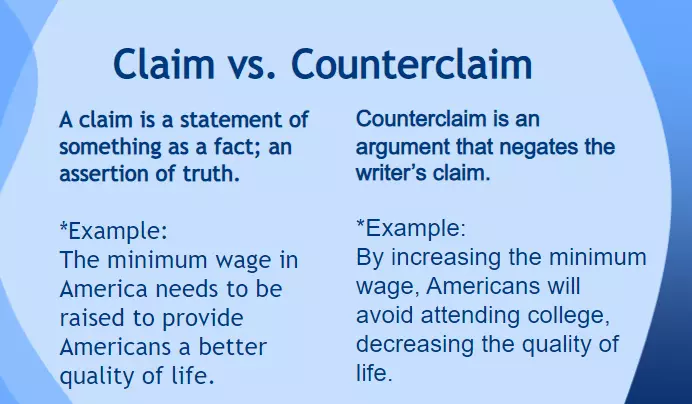- Learning Tips
- Exam Guides
- School Life

How to write a Counterclaim Paragraph, Sentence or Rebuttal
- by Joseph Kenas
- January 18, 2024

If you are writing an argumentative essay, you will find yourself including counterclaims. In this guide, we guide you on how to write a good counterclaim in an essay and how to frame your counterclaim sentence and paragraph in rebuttal.
Counterclaims are mostly included in an argumentative essay where you are required to convince your readers to agree with your arguments and point of view concerning the topic in question.
What is a Counterclaim in an Essay?
A counterclaim can be regarded as the argument or arguments that oppose the thesis statement in your essay. Within the introduction, you introduce the topic and create a thesis statement in the last sentence that makes it clear to your audience the point(s) you want to prove and the strategy you will use to prove it.
The counterclaim demonstrates to the reader that you have put into consideration the perspectives of the opposing side and you find such perspectives to be weak.
As such, a counterclaim will allow you to respond to the potential arguments of your readers before they complete reading the essay.
Additionally, a counterclaim demonstrates that both sides of the debate have been put into consideration, hence strengthening your position.
Difference Between a Claim and a Counterclaim
There is a big difference between a claim and a counterclaim. When writing essays, one may need to include both in the same essay, especially when presenting an argumentative topic.
The difference between a claim and a counterclaim lies in their assertion. A claim is a statement that demonstrates the position of argument or the assertion of a fact or a truth. On the other hand, a counterclaim is an argument that negates a specific claim by rebutting it. While a claim asserts the writer’s argument, a counterclaim rebuts.
When writing an essay, particularly an argumentative essay, you will have a topic and a thesis statement that will show the readers the points you are going to prove and how you will prove them.

Most of your paper will be dedicated to proving your claim to the reader so that they can agree with your point of view.
A good claim should be arguable and at times controversial to allow the readers to think otherwise about your perspectives as the writer.
It can also come up with their interpretations concerning the topic.
Because of this, the essay will be based on the claim and you will demonstrate why your claim is accepted. On the other hand, a counterclaim is a statement of opposition that will allow the readers to perceive the whole picture of the arguments.
Though this is the case, the counterclaim demonstrates that the writer has anticipated arguments against their claim and has provided proof, through the counterclaim, that the readers’ perspectives are false or weak.
As such, when the counterclaim is stated, it is addressed concerning its weaknesses or limitations. This enhances the claim’s strength.
How to Write a Good Counterclaim in an Essay
If you wish to write a good counterclaim, make sure that it takes the form of two stages.

The first stage is where you go against your claim or argument so that you can challenge it and the second stage is where you turn back to your claim or argument to re-affirm it.
When writing a good counterclaim, you imagine that some of your readers will be skeptical and you have to make them agree with you.
For example, if you want to present a counterclaim showing that there was a problem with how you demonstrated your claims, like an unwarranted assumption, certain evidence was played down or ignored, and so on, you can support the counterclaim by presenting the disadvantages or drawbacks of the issues with the presentation. Then, give an alternative proposal or alternative that would make more sense to the readers.
To refute the counterclaim, you announce with words like ‘yet’, ‘but’, ‘however’, ‘still’, or ‘nevertheless’ to indicate that you are about to show why the counterclaim is wrong. Acknowledge that it is a good claim but demonstrate that yours might help the argument more.
Where to Write a Counterclaim in an Essay
A counterclaim can be included anywhere within the body of the essay except the conclusion. There are some cases where you can write a counterclaim at the second last sentence of the introduction paragraph followed by the thesis statement which acts as the refutation.
You can also write a counterargument after the introduction to show the anticipated reaction to your point of view before moving forward with writing your actual claims.
Moving forward, the reason why you cannot place the counterclaim within the conclusion is that you have to include a rebuttal paragraph or statements after you have written the counterclaim. Therefore, a counterclaim located at the conclusion will miss the rebuttal paragraph or statements.
However, argumentative essays can take different structures. Even though such essays will have a basic structure of an introduction, body paragraphs, and a conclusion, the differences will occur within the body paragraphs. Such differences dictate where the counterclaim(s) are located.
There is a structure where the counterclaims are located within all the body paragraphs. In this case, you will write your claim, followed by a counterclaim, and then a rebuttal. This means that for every claim you present to support your thesis, there will be a counterclaim and a rebuttal.
The most common structure is where you present your claims and present the counterclaim(s) before the conclusion. The counterclaim is immediately followed by a rebuttal.
Dos and Don’ts of Writing a Counterclaim
When it comes to the dos of writing a counterclaim, always ensure that it is followed by a rebuttal to demonstrate that your claims are superior to it. Secondly, courteously present your counterclaims to avoid upsetting the reader.

Acknowledge the anticipated arguments from the readers.
Demonstrate that the readers’ points of view are valid but your perspective makes more sense.
Finally, appeal to the logic of the readers through the use of valid evidence.
Concerning the don’ts when writing a counterclaim, do not include a counterargument just for the sake of it.
Make sure that the counterargument is valid in its own right and it is verifiable through evidence.
This is because your readers will also use logic and evidence when thinking about your claims. Secondly, do not use a disrespectful or uncourteous tone when addressing the other side of the argument.
Examples of Counterclaims
A counterclaim in a separate paragraph.
Counterclaim: “Opponents argue that after-school sports can increase the likelihood of sports-related injuries (Bancroft, 2018). Even minor injuries sustained from participation in after-school sports increase absent rates and the expense of creating injury reports for students (Sizemore, 2019)” .
Refutation: “Although students do suffer both serious and minor injuries in after-school sports, these injuries are quite rare (Kinney, 2016) .
Embedded Within a Paragraph
“Without free after-school sports programs, many students would still play sports without adult supervision and even more injuries would result”. Counterclaim : “However, some people would argue that after-school sports can increase the likelihood of sports-related injuries (Sizemore 2019)”. Refutation: “Although students do suffer both serious and minor injuries in after-school sports, without school-sponsored sports, the likelihood of more injuries from less supervised recreational leagues or privately sponsored leagues with fewer safety regulations would be much worse” .
How Long Should a Counterclaim Be?
A counterclaim can be as long as a paragraph if it appears after the introduction paragraph or at the end of the body before the conclusion. However, if a counterclaim is located within a paragraph, it can be a few sentences long (2-3).
However, the length of a counterclaim depends on the length of a claim in general. You can learn more about how to write a claim paragraph in that guide so that you can learn the two in general.
How many Counterclaims can you Put?
This depends on the structure of the essay. If the counterclaim appears after the introduction or before the conclusion, then it will only be one. However, if it is embedded within paragraphs, then they will be as many as the supportive augments.
This is because they will be used to refute every claim made within the body paragraph. If your supporting claims are 5 then the counterclaims will be 5 and so on.
Check out how to write college essays in our guide that we hope will lead you to score well.

Joseph is a freelance journalist and a part-time writer with a particular interest in the gig economy. He writes about schooling, college life, and changing trends in education. When not writing, Joseph is hiking or playing chess.
- Link to facebook
- Link to linkedin
- Link to twitter
- Link to youtube
- Writing Tips
A Guide to Rebuttals in Argumentative Essays

4-minute read
- 27th May 2023
Rebuttals are an essential part of a strong argument. But what are they, exactly, and how can you use them effectively? Read on to find out.
What Is a Rebuttal?
When writing an argumentative essay , there’s always an opposing point of view. You can’t present an argument without the possibility of someone disagreeing.
Sure, you could just focus on your argument and ignore the other perspective, but that weakens your essay. Coming up with possible alternative points of view, or counterarguments, and being prepared to address them, gives you an edge. A rebuttal is your response to these opposing viewpoints.
How Do Rebuttals Work?
With a rebuttal, you can take the fighting power away from any opposition to your idea before they have a chance to attack. For a rebuttal to work, it needs to follow the same formula as the other key points in your essay: it should be researched, developed, and presented with evidence.
Rebuttals in Action
Suppose you’re writing an essay arguing that strawberries are the best fruit. A potential counterargument could be that strawberries don’t work as well in baked goods as other berries do, as they can get soggy and lose some of their flavor. Your rebuttal would state this point and then explain why it’s not valid:
Read on for a few simple steps to formulating an effective rebuttal.
Step 1. Come up with a Counterargument
A strong rebuttal is only possible when there’s a strong counterargument. You may be convinced of your idea but try to place yourself on the other side. Rather than addressing weak opposing views that are easy to fend off, try to come up with the strongest claims that could be made.
In your essay, explain the counterargument and agree with it. That’s right, agree with it – to an extent. State why there’s some truth to it and validate the concerns it presents.
Step 2. Point Out Its Flaws
Now that you’ve presented a counterargument, poke holes in it . To do so, analyze the argument carefully and notice if there are any biases or caveats that weaken it. Looking at the claim that strawberries don’t work well in baked goods, a weakness could be that this argument only applies when strawberries are baked in a pie.
Find this useful?
Subscribe to our newsletter and get writing tips from our editors straight to your inbox.
Step 3. Present New Points
Once you reveal the counterargument’s weakness, present a new perspective, and provide supporting evidence to show that your argument is still the correct one. This means providing new points that the opposer may not have considered when presenting their claim.
Offering new ideas that weaken a counterargument makes you come off as authoritative and informed, which will make your readers more likely to agree with you.
Summary: Rebuttals
Rebuttals are essential when presenting an argument. Even if a counterargument is stronger than your point, you can construct an effective rebuttal that stands a chance against it.
We hope this guide helps you to structure and format your argumentative essay . And once you’ve finished writing, send a copy to our expert editors. We’ll ensure perfect grammar, spelling, punctuation, referencing, and more. Try it out for free today!
Frequently Asked Questions
What is a rebuttal in an essay.
A rebuttal is a response to a counterargument. It presents the potential counterclaim, discusses why it could be valid, and then explains why the original argument is still correct.
How do you form an effective rebuttal?
To use rebuttals effectively, come up with a strong counterclaim and respectfully point out its weaknesses. Then present new ideas that fill those gaps and strengthen your point.
Share this article:
Post A New Comment
Got content that needs a quick turnaround? Let us polish your work. Explore our editorial business services.
5-minute read
Free Email Newsletter Template
Promoting a brand means sharing valuable insights to connect more deeply with your audience, and...
6-minute read
How to Write a Nonprofit Grant Proposal
If you’re seeking funding to support your charitable endeavors as a nonprofit organization, you’ll need...
9-minute read
How to Use Infographics to Boost Your Presentation
Is your content getting noticed? Capturing and maintaining an audience’s attention is a challenge when...
8-minute read

Why Interactive PDFs Are Better for Engagement
Are you looking to enhance engagement and captivate your audience through your professional documents? Interactive...
7-minute read
Seven Key Strategies for Voice Search Optimization
Voice search optimization is rapidly shaping the digital landscape, requiring content professionals to adapt their...
Five Creative Ways to Showcase Your Digital Portfolio
Are you a creative freelancer looking to make a lasting impression on potential clients or...

Make sure your writing is the best it can be with our expert English proofreading and editing.
How to Write an Effective Counterclaim in 5 Steps
So, you’re laboring over a killer argumentative essay — and you want to make absolutely sure that you have all your bases covered? Your essay absolutely needs at least one counterclaim with a rebuttal if you are determined to make it the best it can be.
Unless you are already an experiences essayist, however, it can prove tough to write a solid counterclaim. Watch and learn — with this guide, you’ll get ready to write a powerful counterclaim in no time!
Essay Counterclaim: The Basics
The “too long; didn’t read” version is as follows — a counterclaim is a rhetorical tool used in essay writing. You present a viewpoint for which you are not arguing in a counterclaim, and then proceed to refute it; explaining why people should disagree with the opposing argument and agree with you, instead.
As you’re writing your essay, you will inevitably make various claims. Claims can be defined as debatable statements — the views for which you are arguing in your essay. Your thesis statement will be the main, overarching, claim you make in your essay, and this can be followed by multiple further claims in favor of your argument.
Let’s see this in action:
- Thesis: “Unleashed dogs are a serious public health concern in Masonville. Policy must be amended to make it mandatory for all dogs to be leashed, at all times, and fines must be imposed on those who fail to comply.”
- Claim: “Unleashed dogs have decimated the local deer population.”
- Claim: “5 children and an elderly person have sustained serious dog bites that required medical attention in the last three years.”
- Claim: “Data from other jurisdictions shows that imposing penalties for unleashed dogs reduces incidents with dogs immensely.”
If your essay looks something like this, you’re building a compelling case. You have defined your viewpoint, offered arguments that lead to a conclusion, and you have also shared data that your proposed solution could work.
What’s missing?
To truly make a convincing argument, you have to show that you understand the subject matter you are tackling deeply — something that inevitably includes listening to the opposing side in the argument.
That is where your counterclaim comes in. A counterclaim can be defined as a claim that directly opposes yours.
If your reaction is “Wait, what!? I have to argue against myself?” right now, hold on. There are multiple strong reasons to include a counterclaim in your essay. Here’s a look:
- By including a counterclaim, or indeed multiple, you show that you don’t have tunnel vision. You have also considered the other side.
- Readers who support the other side of the argument will likely react with a “Yes, that’s right!”. This has the effect of making them feel heard, which in turn makes them more open to listening to you.
- After all that, you can — finally — respectfully and artfully refute the counterclaim. You understand the opposing viewpoint and you have deeply considered its merits, but you disagree. Lay out why, and why those who previously agreed with the opposing argument might want to consider coming over to your side, instead.
Let’s see that in action again:
Many dog owners claim that leashing dogs robs them of the ability to run around and have fun — something they consider integral to their dogs’ health and wellbeing. While it is certainly true that dogs need exercise, long leashes allow for plenty of freedom of movement. Dog parks, where dogs could run free, are another possible solution in this case.
Claim vs Counterclaim: What Is the Difference?
The difference between a claim and a counterclaim can best be summed up by saying that a claim is used to argue the position you are defending in your essay, while a counterclaim takes the opposing viewpoint. A counterclaim is an argument against your argument, in other words.
That is not the only difference between the two. To make an effective claim, a writer simply has to:
- Make the claim.
- Provide evidence or logical arguments supporting the claim.
- Where desired, follow this with rhetorical tools such as appeals to emotion or logic to further convince the audience.
A counterclaim requires more elements:
- The counterclaim itself — which states an opposing argument.
- Evidence that people in fact hold this view is very much welcomed; to make a good counterclaim, you cannot simply lay out positions that are almost never taken.
- An explanation as to why people may hold this view.
- Finally, a rebuttal, in which you explain why the counterclaim is weak, and your original position is correct.
How to Write an Effective Counterclaim: Step-by-Step
Writing an effective counterclaim — or even several, as you may be called to do in longer essays — can be challenging. That is particularly true if you fervently believe in the argument you are making, and have a hard time understanding how anyone could disagree with it.
However, it is important to remain as objective as possible as you craft a counterclaim for your essay. Here is a look at the process you may use to decide on a good counterclaim.
- Deciding Where to Place Your Counterclaim
It is typically very effective to open your essay with a compelling hook, which may consist of a powerful anecdote, statistics, or a dramatic introduction to a pressing problem. You will then want to introduce your thesis statement, and begin making claims — which you back up with evidence and further arguments.
Your counterclaim, or counter claims, should be placed after this portion of your essay. In short essays, that means it will be somewhere near the end. However, you will want to summarize your main argument succinctly and write a memorable conclusion in the paragraphs that follow your counterclaim paragraph.
- Deciding How Long Your Counterclaim Should Be
The length of a counterclaim, and indeed the number of counterclaims you decide to include, depends on the target length of your essay. You will typically require at least a short paragraph to be able to do your counterclaim justice, because you are not simply stating that some people disagree with your argument. You also want to explain why.
In some cases, you will be able to write a short rebuttal in the same paragraph. In others, you may choose to refute the counterclaim in the next paragraph.
- Researching Opposing Viewpoints
To write an effective counterclaim, it is important to understand the arguments that may be used to oppose your claims. Don’t simply turn your claim or thesis statement on its head, but research why people disagree with the argument you are making, and on what basis. Where possible, try to find out how common the view you are portraying in your counterclaim is.
- Presenting the Opposing Viewpoint Fairly
Once you immerse yourself in the types of arguments people who disagree with your thesis make, and truly understand where they are coming from, you are ready to craft a good counterclaim. Try this exercise first. Imagine what you would write if you sincerely held the opposing view, and then go ahead and do it.
- Writing Your Counterclaim Paragraph
Before presenting the counterclaim, you will need to introduce the fact that you will be doing this by making a smooth transition in your writing. Good ways to start your counterclaim paragraph include:
- “Critics have argued that…”
- “Some people may conclude that”
- “On the other side of the argument, people are concerned that…”
- “The opposing viewpoint states that…”
Once you have stated the alternative view, go ahead and describe why that view is held. Present evidence.
You can now either start a new paragraph to write a rebuttal, or — if you can keep it short — do so in the same paragraph.
A rebuttal can include:
- Reasons why the opposing view you presented in your counterclaim is weak or false.
- An acknowledgment that the views presented in the counterclaim have merit, but there is a solution that would render the concerns the opposing side has baseless.
- An explanation that the views presented in the counterclaim are exceedingly rare, or the benefits of your argument outweigh the risks the counterclaim sets forth.
Additional Tips on Writing a Counterclaim
If you have followed along so far, you are almost ready to make a very effective counterclaim, complete with a refutation. You may even have penned a draft. So far, so good, but you do have some additional things to watch out for as you write your counterclaim:
- Be objective in the language you use. Do not state that you disagree with the counterclaim, or argue that some people “erroneously believe that…”, for example. Simply present the counterclaim as an alternative opinion.
- Be fair. Do not caricature the viewpoint you are presenting in your counterclaim. Do not use condescending language. When you share the opposing argument, do so using words that those who hold that view may, in fact, use.
- Don’t forget to include evidence. Your evidence can demonstrate that a significant percentage of people hold the view you address in your counterclaim, and it should also, where possible, back up the counterclaim. In the example we used earlier, regarding the benefits of allowing dogs to run around without being leashed, you could look for studies that show that dogs need a certain amount of physical exercise.
- Be fair in your rebuttal, too. The extent to which you do this depends on your aim. If you are writing a high school or college essay, you may simply prefer to throw some hard-hitting verbal punches. If, on the other hand, you are sincerely hoping to convince people who currently hold the alternative opinion you just described that you are right, you will have to be more careful. Validate their underlying concerns or values, and explain why your argument works within that context.
Does every essay need a counterclaim?
No. There are many kinds of essays. An expository essay, for instance, simply explores a topic, and will not need a counterclaim. A narrative essay shares the writer’s personal experience, and will not require a counterclaim. Counterclaims have an important place in argumentative essays, which require the writer to demonstrate that they understand the topic thoroughly and have considered all sides.
How many counterclaims should I include?
If you make multiple claims, you may choose to write a counterclaim for each of them. Depending on the length of your essay, you may even decide to include multiple counterclaims for each claim.
Related posts:
- How to Write an Effective Claim (with Examples)
- How to Write a Counter Argument (Step-by-Step Guide)
- 14 Tips to Help you Write An Essay Fast
- Going to the Dogs - Meaning, Origin and Usage
- How to Write in the First Person Effectively
- How To Write A Movie Title In An Essay
Leave a Reply Cancel reply
Your email address will not be published. Required fields are marked *
- How It Works
- PhD thesis writing
- Master thesis writing
- Bachelor thesis writing
- Dissertation writing service
- Dissertation abstract writing
- Thesis proposal writing
- Thesis editing service
- Thesis proofreading service
- Thesis formatting service
- Coursework writing service
- Research paper writing service
- Architecture thesis writing
- Computer science thesis writing
- Engineering thesis writing
- History thesis writing
- MBA thesis writing
- Nursing dissertation writing
- Psychology dissertation writing
- Sociology thesis writing
- Statistics dissertation writing
- Buy dissertation online
- Write my dissertation
- Cheap thesis
- Cheap dissertation
- Custom dissertation
- Dissertation help
- Pay for thesis
- Pay for dissertation
- Senior thesis
- Write my thesis
How To Write A Counterclaim For A Successful Result

You might have probably heard about a counterclaim or written one that did not go well with you, which is why you are here. We understand your frustrations and anxiety about writing counterclaims, which is why we developed this comprehensive article.
Here is what to expect:
An in-depth explanation of what a counterclaim is The necessity of a counterclaim How to write a good counterclaim Characteristics of an excellent counterclaim Structure and formatting of counterclaims
After reading this post, you will have all the information you need to craft an award-winning paper. We will not leave anything to chance until you know how to write a counterclaim like a top-class student!
Table of Contents
What is a counterclaim in writing, why is a counterclaim necessary, how to write a counterclaim from scratch, detailed guide on how to start a counterclaim paragraph, how to write rebuttal, characteristics of a good counterclaim, example of a good counterclaim.
A counterclaim refers to an argument that opposes the author’s claim. The writer presents the claim and then refutes it, giving reasons why others should not take up the contrary view and agree with their initial stand.
The counterclaim opposes the thesis statement in your essay. So, this is how a counterclaim comes about:
- You first introduce the topic in the introductory paragraph
- Create a thesis statement in the last sentence
- Write a counterclaim that rebuts the initial argument
Many students fail to appreciate the fact that there is a difference between a claim and a counterclaim. The claim demonstrates your position of argument or the assertion of a fact, whereas a counterclaim negates a specific claim by refuting it.
Any top-rated argumentative will always have a counterclaim which disagrees with and disapproves of a claim. Such a claim also provides reasoning that further clarifies a particular argument. The two main purposes of a counterclaim are as follows:
It enhances the credibility of the author: A strong argumentative essay will utilize the rhetorical appeal of ethos. With a counterclaim, a writer will prove that they researched extensively on the topic and are not trying to hide possible information from the audience. It also allows the writer to provide a rebuttal to the essay. The rebuttal is used to disprove the counterclaim within the writer’s argument.
For instance, if the claim is that the government should ban gun use, the counterclaim would be that it should not ban it because it infringes on human rights. There should always be reasons and evidence for you to have a successful counterclaim.
In the next few lines, we will provide all you need to know about starting a counterclaim and delivering the best! So stay tuned.
Every successful essay begins with thorough background research on the topic of discussion. Exploring all possible angles of your essay before embarking on the writing process is recommended—those who end up with a good counterclaim put in extra hours in research and extensive consultation.
You can read thousands of articles on how to write a counterclaim, but without the right background research strategies, that great essay might amount to nothing. So, if you want to crack your counterclaim paragraph like a guru, here are excellent tips for you:
Understand your topic Explore what previous authors have done on it Identify the knowledge gaps Seek facts to defend your claim
Once you have all the information needed for your topic, nothing will stand in the way of you writing a top-notch paper that will impress your professor. When you have factual proof of every statement you make in your essay, you will have a non-biased and credible paper. That means that the sources you use should always be credible and directly relevant to the topic of your essay.
After stating all the base knowledge you need about counterclaims, we now want to dive into the practical part of writing a counterclaim argument. Let’s explore how to write counterclaims by looking at the elements needed:
- The main counterclaim: It states an opposing argument to the claim.
- The evidence includes a previous position to show that others welcome the view.
- An explanation entails providing reasons why people hold the particular view you presented.
- A rebuttal: Here, you will explain the weakness of the counterclaim and present show why your original position is correct.
The process might be challenging initially, but with the right tools and expert advice, you will be up and running in minutes. A counterclaim is included in argumentative writing to address the opposite side of the argument and provide a rebuttal.
The process of writing an outstanding counterclaim in an argumentative essay is as follows:
Where do you put a counterclaim in an essay? Every top-ranking essay begins with a catchy intro comprising statistics or a rather dramatic intro to a particular problem. The thesis statement follows, and the then claim comes on stage. Therefore, the counterclaim comes after you have backed up your claims with evidence and further arguments. How long is the counterclaim? It depends on the number of counterclaims and the overall length of your essay. A typical counterclaim should be at least one paragraph long. Remember that you are not just stating it but explaining why it is so. That is why most guides on writing a counterclaim and rebuttal will recommend either writing them in one paragraph or separately. What different points of view do others hold? You should always understand all the possible points that may arise to counter your claim. Researching why people oppose your claim will give you room for a balanced and reliable paper. It requires a creative mind to determine how your claim goes against the common view. How to introduce a counterclaim now: The general rule is that you should present the contrary opinion fairly. You will only be ready to craft a brilliant counterclaim once you dive into the possible arguments that others who oppose your thesis make. Sincerely present the contrary opinion fairly.
Always remember to use transitions when moving on to present your counterclaim. Just like in a debate, the contrary side will come after the proposers have made their submissions. Therefore, you can begin your counterclaim paragraphs with the following:
- On the contrary, side
- Critics say that
Having presented the other side, you will detail why people also hold that view. It is where the evidence comes in to solidify your counterclaim.
It is advisable to have it in a similar paragraph where your counterclaim is, but if that is not possible, begin it in a new paragraph. However, always remember to keep it short while bringing out the following:
- How the contrary position in your counterclaim is false or weak.
- Presenting the advantages in the counterclaim but giving reasons why the opposite view may not hold water.
- Describe how your main argument outweighs the risks in the counterclaim.
After introducing the counterclaim, you have to discuss why the counterclaim is incorrect. You can start the rebuttal in several ways, such as:
Despite this information Nevertheless However
It is your opportunity to prove why the contrary view is wrong.
You cannot achieve this milestone without considering all sides of the argument first. That is why most researchers in college and university take their time before beginning the writing process. It provides a base for the facts and opinions and saves the time one will spend completing the argumentative essay.
Acknowledging the valid points of the other side is necessary for any form of argumentative writing. This practice eliminates the thought of narrow-mindedness from the reader’s point of view, which may make your essay less effective.
Instead of making your argument look weak, a counterclaim will strengthen your essay by proving that you thoughtfully considered all possible angles before writing your essay. Nobody will accuse you of bias or inadequate research when you have a formulated counterclaim.
A good counterclaim, therefore:
Acknowledges what the opposing side says Provides evidence from the opposing side Refutes the point of view and evidence
It is also crucial to state that when you have more than one claim in your paper, there is always an option of writing a counterclaim for each. You are not limited to presenting the different counterclaims in the same essay. However, follow the structure outline above in terms of length and format.
Additional characteristics of a world-class essay include:
- Objectivity in the language use
- Fairness in the diction
- Evidence to back up the counterclaim
- Fairness in the rebuttal
By validating any underlying concerns, you eliminate room for doubt or error. Remember also to explain why your argument works in that context.
Below is a brief example of what a good counterclaim can look like, from professional dissertation writers :
“On the other hand, some students say homework presents unnecessary stress and pressure. This point of view makes sense because the article states that too much homework may be overwhelming for students, which is why most of them do not complete it. However, homework does not harm the student because the article also says that homework is necessary to test students’ understanding after classroom learning. Therefore, even though homework may cause stress and pressure on the student, it does not harm the student in any way.”
From the example, you can note the following:
Phrases that can begin a counterclaim:
On the other hand, some people say Admittedly, some people say Certainly, some people say
Phrases to refer to the initial claim:
However Nevertheless On the other hand
Phrases to bring paragraph to a conclusion:
Thus Therefore As a result
A good counterclaim will always give you an edge over your competitors in any case.
Writing A Counterclaim Can Be Very Easy
Writing an all-inclusive counterclaim is not a big deal if you have all the facts rights – our writing service and master thesis help offers top-notch assistance with an incredible team of writers and research gurus. We will help you identify winning arguments and provide you with the best rebuttals.
Do not second guess what you will score in your counterclaim essay when you can try out our custom thesis writing service today. Make your pick today and improve your score effortlessly.

Leave a Reply Cancel reply
Your email address will not be published. Required fields are marked *
Comment * Error message
Name * Error message
Email * Error message
Save my name, email, and website in this browser for the next time I comment.
As Putin continues killing civilians, bombing kindergartens, and threatening WWIII, Ukraine fights for the world's peaceful future.
Ukraine Live Updates

English Current
ESL Lesson Plans, Tests, & Ideas
- North American Idioms
- Business Idioms
- Idioms Quiz
- Idiom Requests
- Proverbs Quiz & List
- Phrasal Verbs Quiz
- Basic Phrasal Verbs
- North American Idioms App
- A(n)/The: Help Understanding Articles
- The First & Second Conditional
- The Difference between 'So' & 'Too'
- The Difference between 'a few/few/a little/little'
- The Difference between "Other" & "Another"
- Check Your Level
- English Vocabulary
- Verb Tenses (Intermediate)
- Articles (A, An, The) Exercises
- Prepositions Exercises
- Irregular Verb Exercises
- Gerunds & Infinitives Exercises
- Discussion Questions
- Speech Topics
- Argumentative Essay Topics
- Top-rated Lessons
- Intermediate
- Upper-Intermediate
- Reading Lessons
- View Topic List
- Expressions for Everyday Situations
- Travel Agency Activity
- Present Progressive with Mr. Bean
- Work-related Idioms
- Adjectives to Describe Employees
- Writing for Tone, Tact, and Diplomacy
- Speaking Tactfully
- Advice on Monetizing an ESL Website
- Teaching your First Conversation Class
- How to Teach English Conversation
- Teaching Different Levels
- Teaching Grammar in Conversation Class
- Members' Home
- Update Billing Info.
- Cancel Subscription
- North American Proverbs Quiz & List
- North American Idioms Quiz
- Idioms App (Android)
- 'Be used to'" / 'Use to' / 'Get used to'
- Ergative Verbs and the Passive Voice
- Keywords & Verb Tense Exercises
- Irregular Verb List & Exercises
- Non-Progressive (State) Verbs
- Present Perfect vs. Past Simple
- Present Simple vs. Present Progressive
- Past Perfect vs. Past Simple
- Subject Verb Agreement
- The Passive Voice
- Subject & Object Relative Pronouns
- Relative Pronouns Where/When/Whose
- Commas in Adjective Clauses
- A/An and Word Sounds
- 'The' with Names of Places
- Understanding English Articles
- Article Exercises (All Levels)
- Yes/No Questions
- Wh-Questions
- How far vs. How long
- Affect vs. Effect
- A few vs. few / a little vs. little
- Boring vs. Bored
- Compliment vs. Complement
- Die vs. Dead vs. Death
- Expect vs. Suspect
- Experiences vs. Experience
- Go home vs. Go to home
- Had better vs. have to/must
- Have to vs. Have got to
- I.e. vs. E.g.
- In accordance with vs. According to
- Lay vs. Lie
- Make vs. Do
- In the meantime vs. Meanwhile
- Need vs. Require
- Notice vs. Note
- 'Other' vs 'Another'
- Pain vs. Painful vs. In Pain
- Raise vs. Rise
- So vs. Such
- So vs. So that
- Some vs. Some of / Most vs. Most of
- Sometimes vs. Sometime
- Too vs. Either vs. Neither
- Weary vs. Wary
- Who vs. Whom
- While vs. During
- While vs. When
- Wish vs. Hope
- 10 Common Writing Mistakes
- 34 Common English Mistakes
- First & Second Conditionals
- Comparative & Superlative Adjectives
- Determiners: This/That/These/Those
- Check Your English Level
- Grammar Quiz (Advanced)
- Vocabulary Test - Multiple Questions
- Vocabulary Quiz - Choose the Word
- Verb Tense Review (Intermediate)
- Verb Tense Exercises (All Levels)
- Conjunction Exercises
- List of Topics
- Business English
- Games for the ESL Classroom
- Pronunciation
- Teaching Your First Conversation Class
- How to Teach English Conversation Class
Argumentative Essays: The Counter-Argument & Refutation
An argumentative essay presents an argument for or against a topic. For example, if your topic is working from home , then your essay would either argue in favor of working from home (this is the for side) or against working from home.
Like most essays, an argumentative essay begins with an introduction that ends with the writer's position (or stance) in the thesis statement .
Introduction Paragraph
(Background information....)
- Thesis statement : Employers should give their workers the option to work from home in order to improve employee well-being and reduce office costs.
This thesis statement shows that the two points I plan to explain in my body paragraphs are 1) working from home improves well-being, and 2) it allows companies to reduce costs. Each topic will have its own paragraph. Here's an example of a very basic essay outline with these ideas:
- Background information
Body Paragraph 1
- Topic Sentence : Workers who work from home have improved well-being .
- Evidence from academic sources
Body Paragraph 2
- Topic Sentence : Furthermore, companies can reduce their expenses by allowing employees to work at home .
- Summary of key points
- Restatement of thesis statement
Does this look like a strong essay? Not really . There are no academic sources (research) used, and also...
You Need to Also Respond to the Counter-Arguments!
The above essay outline is very basic. The argument it presents can be made much stronger if you consider the counter-argument , and then try to respond (refute) its points.
The counter-argument presents the main points on the other side of the debate. Because we are arguing FOR working from home, this means the counter-argument is AGAINST working from home. The best way to find the counter-argument is by reading research on the topic to learn about the other side of the debate. The counter-argument for this topic might include these points:
- Distractions at home > could make it hard to concentrate
- Dishonest/lazy people > might work less because no one is watching
Next, we have to try to respond to the counter-argument in the refutation (or rebuttal/response) paragraph .
The Refutation/Response Paragraph
The purpose of this paragraph is to address the points of the counter-argument and to explain why they are false, somewhat false, or unimportant. So how can we respond to the above counter-argument? With research !
A study by Bloom (2013) followed workers at a call center in China who tried working from home for nine months. Its key results were as follows:
- The performance of people who worked from home increased by 13%
- These workers took fewer breaks and sick-days
- They also worked more minutes per shift
In other words, this study shows that the counter-argument might be false. (Note: To have an even stronger essay, present data from more than one study.) Now we have a refutation.
Where Do We Put the Counter-Argument and Refutation?
Commonly, these sections can go at the beginning of the essay (after the introduction), or at the end of the essay (before the conclusion). Let's put it at the beginning. Now our essay looks like this:
Counter-argument Paragraph
- Dishonest/lazy people might work less because no one is watching
Refutation/Response Paragraph
- Study: Productivity increased by 14%
- (+ other details)
Body Paragraph 3
- Topic Sentence : In addition, people who work from home have improved well-being .
Body Paragraph 4
The outline is stronger now because it includes the counter-argument and refutation. Note that the essay still needs more details and research to become more convincing.

Working from home may increase productivity.
Extra Advice on Argumentative Essays
It's not a compare and contrast essay.
An argumentative essay focuses on one topic (e.g. cats) and argues for or against it. An argumentative essay should not have two topics (e.g. cats vs dogs). When you compare two ideas, you are writing a compare and contrast essay. An argumentative essay has one topic (cats). If you are FOR cats as pets, a simplistic outline for an argumentative essay could look something like this:
- Thesis: Cats are the best pet.
- are unloving
- cause allergy issues
- This is a benefit > Many working people do not have time for a needy pet
- If you have an allergy, do not buy a cat.
- But for most people (without allergies), cats are great
- Supporting Details
Use Language in Counter-Argument That Shows Its Not Your Position
The counter-argument is not your position. To make this clear, use language such as this in your counter-argument:
- Opponents might argue that cats are unloving.
- People who dislike cats would argue that cats are unloving.
- Critics of cats could argue that cats are unloving.
- It could be argued that cats are unloving.
These underlined phrases make it clear that you are presenting someone else's argument , not your own.
Choose the Side with the Strongest Support
Do not choose your side based on your own personal opinion. Instead, do some research and learn the truth about the topic. After you have read the arguments for and against, choose the side with the strongest support as your position.
Do Not Include Too Many Counter-arguments
Include the main (two or three) points in the counter-argument. If you include too many points, refuting these points becomes quite difficult.
If you have any questions, leave a comment below.
- Matthew Barton / Creator of Englishcurrent.com
Additional Resources :
- Writing a Counter-Argument & Refutation (Richland College)
- Language for Counter-Argument and Refutation Paragraphs (Brown's Student Learning Tools)
EnglishCurrent is happily hosted on Dreamhost . If you found this page helpful, consider a donation to our hosting bill to show your support!
26 comments on “ Argumentative Essays: The Counter-Argument & Refutation ”
Thank you professor. It is really helpful.
Can you also put the counter argument in the third paragraph
It depends on what your instructor wants. Generally, a good argumentative essay needs to have a counter-argument and refutation somewhere. Most teachers will probably let you put them anywhere (e.g. in the start, middle, or end) and be happy as long as they are present. But ask your teacher to be sure.
Thank you for the information Professor
how could I address a counter argument for “plastic bags and its consumption should be banned”?
For what reasons do they say they should be banned? You need to address the reasons themselves and show that these reasons are invalid/weak.
Thank you for this useful article. I understand very well.
Thank you for the useful article, this helps me a lot!
Thank you for this useful article which helps me in my study.
Thank you, professor Mylene 102-04
it was very useful for writing essay
Very useful reference body support to began writing a good essay. Thank you!
Really very helpful. Thanks Regards Mayank
Thank you, professor, it is very helpful to write an essay.
It is really helpful thank you
It was a very helpful set of learning materials. I will follow it and use it in my essay writing. Thank you, professor. Regards Isha
Thanks Professor
This was really helpful as it lays the difference between argumentative essay and compare and contrast essay.. Thanks for the clarification.
This is such a helpful guide in composing an argumentative essay. Thank you, professor.
This was really helpful proof, thankyou!
Thanks this was really helpful to me
This was very helpful for us to generate a good form of essay
thank you so much for this useful information.
Thank you so much, Sir. This helps a lot!
Thank you for the information l have learnt a lot.
Thanks so much .i have the basics information i needed
Leave a Reply Cancel reply
Your email address will not be published. Required fields are marked *
